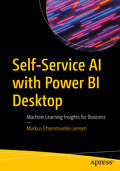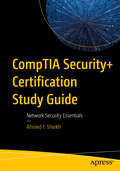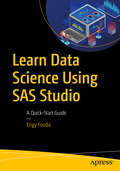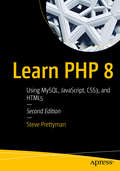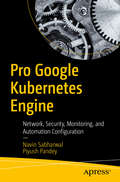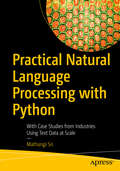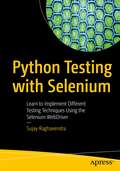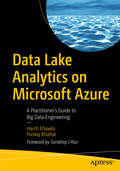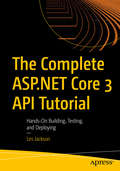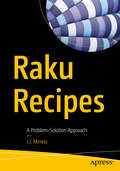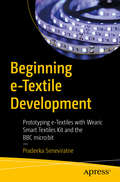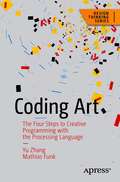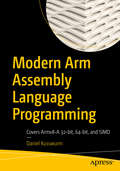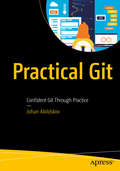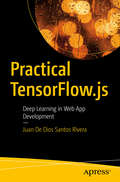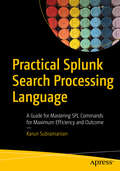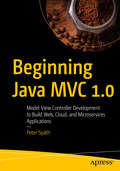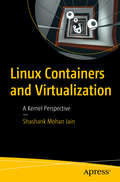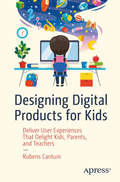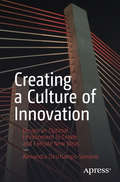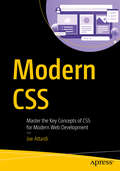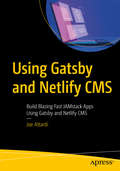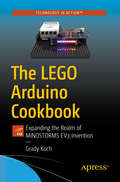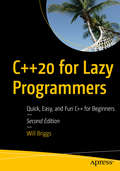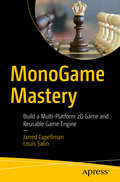- Table View
- List View
Self-Service AI with Power BI Desktop: Machine Learning Insights for Business
by Markus Ehrenmueller-JensenThis book explains how you can enrich the data you have loaded into Power BI Desktop by accessing a suite of Artificial Intelligence (AI) features. These AI features are built into Power BI Desktop and help you to gain new insights from existing data. Some of the features are automated and are available to you at the click of a button or through writing Data Analysis Expressions (DAX). Other features are available through writing code in either the R, Python, or M languages. This book opens up the entire suite of AI features to you with clear examples showing when they are best applied and how to invoke them on your own datasets.No matter if you are a business user, analyst, or data scientist – Power BI has AI capabilities tailored to you. This book helps you learn what types of insights Power BI is capable of delivering automatically. You will learn how to integrate and leverage the use of the R and Python languages for statistics, how to integrate with Cognitive Services and Azure Machine Learning Services when loading data, how to explore your data by asking questions in plain English ... and more! There are AI features for discovering your data, characterizing unexplored datasets, and building what-if scenarios.There’s much to like and learn from this book whether you are a newcomer to Power BI or a seasoned user. Power BI Desktop is a freely available tool for visualization and analysis. This book helps you to get the most from that tool by exploiting some of its latest and most advanced features.What You Will LearnAsk questions in natural language and get answers from your dataLet Power BI explain why a certain data point differs from the restHave Power BI show key influencers over categories of dataAccess artificial intelligence features available in the Azure cloudWalk the same drill down path in different parts of your hierarchyLoad visualizations to add smartness to your reportsSimulate changes in data and immediately see the consequencesKnow your data, even before you build your first reportCreate new columns by giving examples of the data that you needTransform and visualize your data with the help of R and Python scriptsWho This Book Is ForFor the enthusiastic Power BI user who wants to apply state-of-the-art artificial intelligence (AI) features to gain new insights from existing data. For end-users and IT professionals who are not shy of jumping into a new world of machine learning and are ready to make that step and take a deeper look into their data. For those wanting to step up their game from doing simple reporting and visualizations by making the move into diagnostic and predictive analysis.
CompTIA Security+ Certification Study Guide: Network Security Essentials
by Ahmed F. SheikhPrepare for the CompTIA Security+ certification exam that covers the skills required to perform core security functions and pursue a career in IT. You will learn the basic principles of network security. Computer network vulnerabilities and threats are covered and you will learn how to safeguard computer networks. Network security planning, technology, and organization are discussed along with associated legal and ethical issues. Lesson objectives and instruction succinctly review each major topic, including: network fundamentals, operational and organizational security, risk management, wireless security, change management, physical security, forensics, network attacks, and much more. What You Will Learn Identify the concepts of confidentiality, integrity, and availabilityImplement secure network administration principlesApply appropriate risk mitigation strategiesExplain the impact of physical security on computer and network securityUse assessment tools to discover security threats and vulnerabilitiesImplement appropriate security controls when performing account management Who This Book Is For Security professionals looking to get this credential, including systems administrators, network administrators, security administrators, junior IT auditors and penetration testers, security specialists, security consultants, security engineers, and more
Learn Data Science Using SAS Studio: A Quick-Start Guide
by Engy FoudaDo you want to create data analysis reports without writing a line of code? This book introduces SAS Studio, a free data science web browser-based product for educational and non-commercial purposes. The power of SAS Studio comes from its visual point-and-click user interface that generates SAS code. It is easier to learn SAS Studio than to learn R and Python to accomplish data cleaning, statistics, and visualization tasks. The book includes a case study about analyzing the data required for predicting the results of presidential elections in the state of Maine for 2016 and 2020. In addition to the presidential elections, the book provides real-life examples including analyzing stocks, oil and gold prices, crime, marketing, and healthcare. You will see data science in action and how easy it is to perform complicated tasks and visualizations in SAS Studio.You will learn, step-by-step, how to do visualizations, including maps. In most cases, you will not need a line of code as you work with the SAS Studio graphical user interface. The book includes explanations of the code that SAS Studio generates automatically. You will learn how to edit this code to perform more complicated advanced tasks. The book introduces you to multiple SAS products such as SAS Viya, SAS Analytics, and SAS Visual Statistics. What You Will Learn Become familiar with SAS Studio IDEUnderstand essential visualizationsKnow the fundamental statistical analysis required in most data science and analytics reportsClean the most common data set problemsUse linear progression for data predictionWrite programs in SASGet introduced to SAS-Viya, which is more potent than SAS studio Who This Book Is For A general audience of people who are new to data science, students, and data analysts and scientists who are experienced but new to SAS. No programming or in-depth statistics knowledge is needed.
Learn PHP 8: Using MySQL, JavaScript, CSS3, and HTML5
by Steve PrettymanWrite solid, secure, object-oriented code in the new PHP 8. In this book you will create a complete three-tier application using a natural process of building and testing modules within each tier. This practical approach teaches you about app development and introduces PHP features when they are actually needed rather than providing you with abstract theory and contrived examples. In Learn PHP 8, programming examples take advantage of the newest PHP features; you’ll follow a learn-by-doing approach, which provides you with complete coding examples. “Do It” exercises in each chapter provide the opportunity to make adjustments to the example code. The end-of-chapter programming exercises allow you to develop your own applications using the algorithms demonstrated in the chapter. Each tier is logically and physically separated using object-oriented and dependency injection techniques, thus allowing independent tiers that can be updated with little or no effect on the other tiers. In addition to teaching good programming practices through OOP, there is a strong emphasis on creating secure code. As each chapter is completed, you’ll have the opportunity to design and create an application reinforcing the concepts learned. What You Will Learn Program PHP 8 web applications Use interfaces, containers, and platforms Apply modular programming Manage data objects and use MySQL and other databases Work with multi-functional and secure user interfaces Handle logging exceptions and more Who This Book Is For Those new to web development, specifically PHP programming. Also, this book can be useful to those who have some PHP/web development experience who are new to PHP 8.
Pro Google Kubernetes Engine: Network, Security, Monitoring, and Automation Configuration
by Navin Sabharwal Piyush PandeyDiscover methodologies and best practices for getting started with Google Kubernetes Engine (GKE). This book helps you understand how GKE provides a fully managed environment to deploy and operate containerized applications on Google Cloud infrastructure.You will see how Kubernetes makes it easier for users to manage clusters and the container ecosystem. And you will get detailed guidance on deploying and managing applications, handling administration of container clusters, managing policies, and monitoring cluster resources. You will learn how to operate the GKE environment through the GUI-based Google Cloud console and the "gcloud" command line interface. The book starts with an introduction to GKE and associated services. The authors provide hands-on examples to set up Container Registry and GKE Cluster, and you will follow through an application deployment on GKE. Later chapters focus on securing your GCP GKE environment, GKE monitoring and dashboarding, and CI/CD automation. All of the code presented in the book is provided in the form of scripts, which allow you to try out the examples and extend them in interesting ways.What You Will LearnUnderstand the main container services in GCP (Google Container Registry, Google Kubernetes Engine, Kubernetes Engine, Management Services)Perform hands-on steps to deploy, secure, scale, monitor, and automate your containerized environmentDeploy a sample microservices application on GKEDeploy monitoring for your GKE environmentUse DevOps automation in the CI/CD pipeline and integrate it with GKEWho This Book Is ForArchitects, developers, and DevOps engineers who want to learn Google Kubernetes Engine
Practical Natural Language Processing with Python: With Case Studies from Industries Using Text Data at Scale
by Mathangi SriWork with natural language tools and techniques to solve real-world problems. This book focuses on how natural language processing (NLP) is used in various industries. Each chapter describes the problem and solution strategy, then provides an intuitive explanation of how different algorithms work and a deeper dive on code and output in Python. Practical Natural Language Processing with Python follows a case study-based approach. Each chapter is devoted to an industry or a use case, where you address the real business problems in that industry and the various ways to solve them. You start with various types of text data before focusing on the customer service industry, the type of data available in that domain, and the common NLP problems encountered. Here you cover the bag-of-words model supervised learning technique as you try to solve the case studies. Similar depth is given to other use cases such as online reviews, bots, finance, and so on. As you cover the problems in these industries you’ll also cover sentiment analysis, named entity recognition, word2vec, word similarities, topic modeling, deep learning, and sequence to sequence modelling. By the end of the book, you will be able to handle all types of NLP problems independently. You will also be able to think in different ways to solve language problems. Code and techniques for all the problems are provided in the book. What You Will LearnBuild an understanding of NLP problems in industryGain the know-how to solve a typical NLP problem using language-based models and machine learningDiscover the best methods to solve a business problem using NLP - the tried and tested onesUnderstand the business problems that are tough to solve Who This Book Is For Analytics and data science professionals who want to kick start NLP, and NLP professionals who want to get new ideas to solve the problems at hand.
Python Testing with Selenium: Learn to Implement Different Testing Techniques Using the Selenium WebDriver
by Sujay RaghavendraImplement different testing techniques using Selenium WebDriver with the Python programming language. This quick reference provides simple functional test cases with a syntax-based approach for Selenium WebDriver. You’ll begin by reviewing the basics of Selenium WebDriver and its architectural design history and then move on to the configuration and installation of Selenium library for different web browsers, including the basic commands needed to start test scripts in various browsers. You’ll review action commands of keyboard and mouse for testing user interactions in a web page and see how hyperlinks are tested. The book also examines various web elements using eight different locators provided by Selenium to help you choose the one best suited to your needs. All Python scripts are ready to test real examples, all of which are explained thoroughly with problem statements. You’ll use different Python design patterns to automate test scripts that can be incorporated with Selenium. In the end, Python Testing with Selenium will provide you with the expertise to write your own test cases in future. What You’ll Learn Install and configure Selenium WebDriver with Python for different web-browsers Review basic commands of Selenium Locate web elements Work with UI based web elements Assert web elements and handle exceptions Write test scripts in Page Object Model Write test cases with Unittest framework Who This Book Is For Python developers/testers who want to test their web applications
Data Lake Analytics on Microsoft Azure: A Practitioner's Guide to Big Data Engineering
by Harsh Chawla Pankaj KhattarGet a 360-degree view of how the journey of data analytics solutions has evolved from monolithic data stores and enterprise data warehouses to data lakes and modern data warehouses. You willThis book includes comprehensive coverage of how:To architect data lake analytics solutions by choosing suitable technologies available on Microsoft AzureThe advent of microservices applications covering ecommerce or modern solutions built on IoT and how real-time streaming data has completely disrupted this ecosystemThese data analytics solutions have been transformed from solely understanding the trends from historical data to building predictions by infusing machine learning technologies into the solutionsData platform professionals who have been working on relational data stores, non-relational data stores, and big data technologies will find the content in this book useful. The book also can help you start your journey into the data engineer world as it provides an overview of advanced data analytics and touches on data science concepts and various artificial intelligence and machine learning technologies available on Microsoft Azure.What Will You LearnYou will understand the:Concepts of data lake analytics, the modern data warehouse, and advanced data analyticsArchitecture patterns of the modern data warehouse and advanced data analytics solutionsPhases—such as Data Ingestion, Store, Prep and Train, and Model and Serve—of data analytics solutions and technology choices available on Azure under each phaseIn-depth coverage of real-time and batch mode data analytics solutions architectureVarious managed services available on Azure such as Synapse analytics, event hubs, Stream analytics, CosmosDB, and managed Hadoop services such as Databricks and HDInsightWho This Book Is ForData platform professionals, database architects, engineers, and solution architects
The Complete ASP.NET Core 3 API Tutorial: Hands-On Building, Testing, and Deploying
by Les JacksonUse this ASP.NET Core API tutorial and straightforward step-by-step guide to build, test, and deploy an ASP.NET Core API to Azure. It will help you code confidently and efficiently, and provides just what you need for context. The book starts with detailing how to set up your development environment, and then introduces a variety of tools and technologies to build, test, and deploy your API. It covers tools such as .NET Core SDK, (Version 3.1), Visual Studio Code, Git, xUnit, Docker, PostgreSQL, Postman, Azure DevOps, Azure, AutoMapper, and many more.Practical guidance is provided so you can achieve a tangible and valuable outcome, and you also are given a dose of theory on REST (Representational State Transfer), JSON, (JavaScript Object Notation), DTOs (Data Transfer Objects), and the MVC (Model View Controller) architectural pattern.What You Will LearnBuild an ASP.NET Core API using C#, test it, and deploy it to Azure Understand concepts on Entity Framework CoreGain hard-earned secrets, shortcuts, and gotchas throughout the “build along” Get comfortable with ASP NET Core EnvironmentsBe introduced to unit testing, CI/CD pipelines, bearer authentication, and JSON Web Tokens (JWT)Who This Book Is ForDevelopers using the Microsoft stack. Some basic understanding of .NET Core is assumed.
Raku Recipes: A Problem-Solution Approach
by J.J. MereloExplore Raku problems and solutions using the latest version of the Raku programming language. In Raku Recipes, the emphasis is on applying Raku code to various important tasks and applications including data science, analytics, microservices, and desktop/console applications. There are also fun one-liner script recipes and instructions on how to create mini-languages of your very own. All in all, over 70 recipes cover a broad range of the tasks and problems encountered by a modern Raku developer. You’ll be able to solve problems starting from basics such as input/output and math, to more complex domains such as microservices web sockets, web hooks, and mini-bots. What You Will LearnPut Raku to use in a real world environmentWork with Raku modules, including design classes, roles, and more Query a GeoIP database and extract information from the web Carry out text processing such as creating a dictionary with fast searches over it and scraping markdown documents Work with MongoDB, WikiData, and other data sourcesBuild data science and analytics applications using RakuIntegrate with Python, C, and other languages and librariesCreate mini-languages and shell scripting languages Who This Book Is For While some prior experience in Raku may be useful, it is not required. Prior programming experience using earlier versions of Perl is recommended, however.
Beginning e-Textile Development: Prototyping e-Textiles with Wearic Smart Textiles Kit and the BBC micro:bit
by Pradeeka SeneviratneElectronic textiles (e-textiles) involves the combination of electronics and textiles to form "smart" textile products. It is an emerging technology with immense opportunities in the field of wearables fashion technology. And while there are many e-textile development platforms available on the market, this book uses the Wearic smart textile kit, a modular prototyping platform, to get you building projects and experiments easily and quickly.This book presents the essential skills required to get started developing e-textiles. The code presented is built using MakeCode blocks, an easy-to-use visual programming language. You'll use the BBC micro:bit microcontroller for all the projects, and with few exceptions, they require no soldering and wiring. In the end, you'll be able to apply and sew electronics to wearables, garments, and fabrics in this emerging technology.Beginning e-Textile Development presents the essential components to get you started with developing e-textiles. What You'll LearnProgram with the BBC micro:bitAdd lights to your wearables using LED textilesUse different textile sensors to measure heat, detect water, actuate attachments, and enable sense touch and pressureActuate attachments on wearables with muscle activity and heartbeatMake chemistry-based color-changing fabrics using thermochromic pigmentsUtilize Bluetooth Low Energy to send sensor data to mobile apps and WiFi to send sensor data to the ThingSpeak IoT analytics platform serviceWho This Book Is ForBeginners to the e-textile industry seeking a comprehensive toolkit. Fashion designers, Makers, engineers, scientists, and students can all benefit from this book.
Coding Art: The Four Steps to Creative Programming with the Processing Language (Design Thinking)
by Yu Zhang Mathias FunkFinally, a book on creative programming, written directly for artists and designers! Rather than following a computer science curriculum, this book is aimed at creatives who are working in the intersection of design, art, and education. In this book you'll learn to apply computation into the creative process by following a four-step process, and through this, land in the cross section of coding and art, with a focus on practical examples and relevant work structures. You'll follow a real-world use case of computation art and see how it relates back to the four key pillars, and addresses potential pitfalls and challenges in the creative process. All code examples are presented in a fully integrated Processing example library, making it easy for readers to get started.This unique and finely balanced approach between skill acquisition and the creative process and development makes Coding Art a functional reference book for both creative programming and the creative process for professors and students alike.What You’ll LearnReview ideas and approaches from creative programming to different professional domainsWork with computational tools like the Processing languageUnderstand the skills needed to move from static elements to animation to interactionUse interactivity as input to bring creative concepts closer to refinement and depthSimplify and extend the design of aesthetics, rhythms, and smoothness with data structuresLeverage the diversity of art code on other platforms like the web or mobile applicationsUnderstand the end-to-end process of computation art through real world use casesStudy best practices, common pitfalls, and challenges of the creative processWho This Book Is ForThose looking to see what computation and data can do for their creative expression; learners who want to integrate computation and data into their practices in different perspectives; and those who already know how to program, seeking creativity and inspiration in the context of computation and data.
Modern Arm Assembly Language Programming: Covers Armv8-A 32-bit, 64-bit, and SIMD
by Daniel KusswurmGain the fundamentals of Armv8-A 32-bit and 64-bit assembly language programming. This book emphasizes Armv8-A assembly language topics that are relevant to modern software development. It is designed to help you quickly understand Armv8-A assembly language programming and the computational resources of Arm’s SIMD platform. It also contains an abundance of source code that is structured to accelerate learning and comprehension of essential Armv8-A assembly language constructs and SIMD programming concepts. After reading this book, you will be able to code performance-optimized functions and algorithms using Armv8- A 32-bit and 64-bit assembly language. Modern Arm Assembly Language Programming accentuates the coding of Armv8-A 32-bit and 64-bit assembly language functions that are callable from C++. Multiple chapters are also devoted to Armv8-A SIMD assembly language programming. These chapters discuss how to code functions that are used in computationally intense applications such as machine learning, image processing, audio and video encoding, and computer graphics. The source code examples were developed using the GNU toolchain (g++, gas, and make) and tested on a Raspberry Pi 4 Model B running Raspbian (32-bit) and Ubuntu Server (64-bit). It is important to note that this is a book about Armv8-A assembly language programming and not the Raspberry Pi. What You Will Learn See essential details about the Armv8-A 32-bit and 64-bit architectures including data types, general purpose registers, floating-point and SIMD registers, and addressing modes Use the Armv8-A 32-bit and 64-bit instruction sets to create performance-enhancing functions that are callable from C++ Employ Armv8-A assembly language to efficiently manipulate common data types and programming constructs including integers, arrays, matrices, and user-defined structures Create assembly language functions that perform scalar floating-point arithmetic using the Armv8-A 32-bit and 64-bit instruction sets Harness the Armv8-A SIMD instruction sets to significantly accelerate the performance of computationally intense algorithms in applications such as machine learning, image processing, computer graphics, mathematics, and statistics. Apply leading-edge coding strategies and techniques to optimally exploit the Armv8-A 32-bit and 64-bit instruction sets for maximum possible performance Who This Book Is For Software developers who are creating programs for Armv8-A platforms and want to learn how to code performance-enhancing algorithms and functions using the Armv8-A 32-bit and 64-bit instruction sets. Readers should have previous high-level language programming experience and a basic understanding of C++.
Practical Git: Confident Git Through Practice
by Johan AbildskovPractice your Git skills using exercises in your own environment. This book introduces concepts in an abstract visual way, and then enforces this learning through exercises - the Git katas. You will start with basic interactions such as commits and branches, and move on to both internals and collaborative workflows. Best practices are introduced and rehearsed throughout with hands-on exercises. Each topic is supplemented with interactive Git exercises that can be solved using any Git client – either the ubiquituous CLI or one of the many graphical clients so you'll learn in the environment you work in. The importance of Git is hard to overstate – it is used by 90% of software engineers worldwide and is the de facto standard for version control. Honing your Git skills is guaranteed to make you a better and more efficient developer. Building software can be stressful, but it doesn’t need to be. Practical Git will give you the Git skills you need, and help keep your Git skills sharp. Add it to your library today. What You'll LearnUse Git through scripted exercises and the Git katas Understand Git’s graph modelTroubleshoot common and rare scenarios you may faceSelect and apply the right Git tool for the taskMaintain and collaborate on Git repositoriesTweak Git to gain the most from this powerful tool Who This Book Is For Anyone who is currently using Git in a copy-paste fashion. It will take you from using Git to knowing Git.
Practical TensorFlow.js: Deep Learning in Web App Development
by Juan De RiveraDevelop and deploy deep learning web apps using the TensorFlow.js library. TensorFlow.js is part of a bigger framework named TensorFlow, which has many tools that supplement it, such as TensorBoard, ml5js, tfjs-vis. This book will cover all these technologies and show they integrate with TensorFlow.js to create intelligent web apps.The most common and accessible platform users interact with everyday is their web browser, making it an ideal environment to deploy AI systems. TensorFlow.js is a well-known and battle-tested library for creating browser solutions. Working in JavaScript, the so-called language of the web, directly on a browser, you can develop and serve deep learning applications.You'll work with deep learning algorithms such as feedforward neural networks, convolutional neural networks (CNN), recurrent neural networks (RNN), and generative adversarial network (GAN). Through hands-on examples, apply these networks in use cases related to image classification, natural language processing, object detection, dimensionality reduction, image translation, transfer learning, and time series analysis.Also, these topics are very varied in terms of the kind of data they use, their output, and the training phase. Not everything in machine learning is deep networks, there is also what some call shallow or traditional machine learning. While TensorFlow.js is not the most common place to implement these, you'll be introduce them and review the basics of machine learning through TensorFlow.js.What You'll LearnBuild deep learning products suitable for web browsersWork with deep learning algorithms such as feedforward neural networks, convolutional neural networks (CNN), recurrent neural networks (RNN), and generative adversarial network (GAN)Develop apps using image classification, natural language processing, object detection, dimensionality reduction, image translation, transfer learning, and time series analysisWho This Book Is For Programmers developing deep learning solutions for the web and those who want to learn TensorFlow.js with at least minimal programming and software development knowledge. No prior JavaScript knowledge is required, but familiarity with it is helpful.
Practical Splunk Search Processing Language: A Guide for Mastering SPL Commands for Maximum Efficiency and Outcome
by Karun SubramanianUse this practical guide to the Splunk operational data intelligence platform to search, visualize, and analyze petabyte-scale, unstructured machine data. Get to the heart of the platform and use the Search Processing Language (SPL) tool to query the platform to find the answers you need. With more than 140 commands, SPL gives you the power to ask any question of machine data. However, many users (both newbies and experienced users) find the language difficult to grasp and complex. This book takes you through the basics of SPL using plenty of hands-on examples and emphasizes the most impactful SPL commands (such as eval, stats, and timechart). You will understand the most efficient ways to query Splunk (such as learning the drawbacks of subsearches and join, and why it makes sense to use tstats). You will be introduced to lesser-known commands that can be very useful, such as using the command rex to extract fields and erex to generate regular expressions automatically. In addition, you will learn how to create basic visualizations (such as charts and tables) and use prescriptive guidance on search optimization. For those ready to take it to the next level, the author introduces advanced commands such as predict, kmeans, and cluster.What You Will LearnUse real-world scenarios (such as analyzing a web access log) to search, group, correlate, and create reports using SPL commandsEnhance your search results using lookups and create new lookup tables using SPL commandsExtract fields from your search results Compare data from multiple time frames in one chart (such as comparing your current day application performance to the average of the past 30 days) Analyze the performance of your search using Job Inspector and identify execution costs of various components of your search Who This Book Is ForApplication developers, architects, DevOps engineers, application support engineers, network operations center analysts, security operations center (SOC) analysts, and cyber security professionals who use Splunk to search and analyze their machine data
Beginning Java MVC 1.0: Model View Controller Development to Build Web, Cloud, and Microservices Applications
by Peter SpäthGet started with using the new Java MVC 1.0 framework for model, view, and controller development for building modern Java-based web, native, and microservices applications. Beginning Java MVC teaches you the basics, then dives in to models, views, controllers. Next, you learn data binding, events, application types, view engines, and more. You will be given practical examples along the way to reinforce what you have learned. Furthermore, you'll work with annotations, internationalization, security, and deployment. After reading this book, you'll have the know how to build your first full Java-based MVC application. What You Will Learn Discover the Java MVC 1.0 APIs and how to use them Master the Model, View and Controller design pattern Carry out data binding Write events Work with view engines Who This Book Is For Those new to Java MVC 1.0. Some prior experience with Java programming recommended, especially with JSF or Struts.
Linux Containers and Virtualization: A Kernel Perspective
by Shashank Mohan JainGet a novel perspective on Linux containers and understand the world of virtualization. This book takes you down the rabbit hole to discover what lies below the API. You’ll go on a journey of virtualization and see how containers are realized in the Linux world. Linux Containers and Virtualization details the data structures within the Linux kernel which make up Linux containers. You will start with the fundamentals of virtualization including how different resources such as memory, CPU, network, and storage are virtualized. Then you will move on to hypervisors and virtualization using the Kernel virtual Machine (KVM) and Quick Emulator (QEMU). Next, you will learn about Linux namespace, cgroups, and layered file systems, which are the essential building blocks of Linux containers. The explanation traverses the Linux kernel codebase to show how these are realized in the Linux kernel. In the final chapter, you will code your own container by applying the concepts learnt in the previous chapters. On completion of the book, you will have the knowledge to start coding a Linux container. What You Will Learn Understand the basics of virtualizationDiscover how the Linux kernel supports virtualization See how the evolution of the Linux kernel and CPUs led to the creation of containerization technologiesDevelop the ability to create your own container framework Who This Book Is For Developers working on virtualized software deployment and containers. Architects designing platforms based on a container runtime as well as DevOps professionals who want to get a microscopic view on how containers and virtualization work would find the book useful.
Designing Digital Products for Kids: Deliver User Experiences That Delight Kids, Parents, and Teachers
by Rubens CantuniChildhood learning is now more screen-based than ever before, and app developers are flocking in droves to this lucrative and exciting market. The younger generation deserves the best, and growing up in a digital world has made them discerning and demanding customers. Creating a valuable user experience for a child is as complex and involved as when designing a typical app for an adult, if not more, and Designing Digital Products for Kids is here to be your guide. Author and designer Rubens Cantuni recognizes the societal importance of a high-quality and ethical app experience for children. There is room for significant improvement in this space, and Cantuni helps you optimize it. Designing Digital Products for Kids walks hopeful developers through digital product design—including research, concept, design, release, marketing, testing, analyzing, and iterating—all while aiming to build specifically for children. Industry experts and their real-world advice are showcased in this book, along with careful advice for the ethics that go along with this unique market. These tips include complex needs regarding mental development, accessibility, conscious screen time limits, and content sensitivity. Children, parents, and teachers alike are hungry for more thoughtful players in the kids’ app space, and Designing Digital Products for Kids is your ticket to successfully developing and educating for the future. What You Will LearnDesign platforms specifically for children, to entertain and educate themWork with a complex audience of parents, teachers and kidsUnderstand how different monetization strategies work in this industry and why Who This Book Is ForUser experience designers, UI designers, product owners, teachers and educators, startup founders. The range of topics is so wide that anyone interested or involved in digital products could find something interesting to learn.
Creating a Culture of Innovation: Design an Optimal Environment to Create and Execute New Ideas
by Alexandra Deschamps-SonsinoDeconstruct the history of patterns of innovation in business and connect them to existing and failed attempts in management consultancies, engineering, web technologies and academic institutions. This book shows you how to create an optimal environment at work for growth and innovation. Many large-scale organizations eventually invest in research and innovation as a dedicated part of their businesses. In doing so, they are faced with two choices: build their own practice of innovation or enact patterns of innovation created before them, ones they perceived as "tried and tested." In this book, you will see how patterns of innovation touch many aspects of a worker’s life: from how their work is presented to others, job titles, working environment, and expectations around output. Every chapter will offer a history of these patterns and examples of how they have succeeded and failed within organizations. What You Will LearnIdentify how innovation is named and highlighted in organizationsReveal ways to champion innovation to clients and the outside world, from trade shows and conferences inside the officeUncover ways companies acquire innovation, including incubators or mergersDiscover the conditions for innovation to happen every day, including office layouts, time management, communication structures, and expectation management Who This Book Is ForTech start-up/scale-up founders, management consultants, managing directors, innovation managers and heads of R&D, academic researchers, interior designers, and architects
Modern CSS: Master the Key Concepts of CSS for Modern Web Development
by Joe AttardiCome on a tour of “modern” CSS in 2020. This example-driven book demonstrates the concepts by showing code examples, screenshots, and diagrams to help clearly communicate the information.You'll start with the very basics of CSS: box model, colors, selectors and combinators, and specificity. Then gradually move through more intermediate topics - styling text, positioning, Z-index and stacking contexts, gradients, borders, and then to more advanced topics such as transforms, transitions, animations, flexbox, and CSS grid. Some features are only available in modern browsers (Chrome, Edge, Safari, and Firefox), but information about IE11 compatibility is included where possible.There is a lot of discussion about how hard CSS is, and how intimidated some people are by it, but it doesn’t have to be this way. Modern CSS uses a logical and understandable approach to break down and clearly explain the ins and outs of CSS. What You'll Learn Work with the syntax of CSS selectors and calculate specificityUse styling techniques, fonts and text stylingReview custom properties (variables)Explore the different ways an element can be transformedUse animating elements with CSS transitions Position elements using Flexbox layout Understand the basics of responsive design Who This Book Is ForAnyone who has some experience with HTML, and some CSS, but might not be familiar with some of the newer concepts like flexbox or grid. Also, those looking for a refresher in those areas.
Using Gatsby and Netlify CMS: Build Blazing Fast JAMstack Apps Using Gatsby and Netlify CMS
by Joe AttardiLeverage the powerful new combination of Gatsby and Netlify CMS, a free open source content management solution, to build blazing fast apps. This book shows you how to create a React-powered website using the Gatsby framework for the frontend, and Netlify CMS as the content backend. Through the course of the book you'll gradually build a website for a coffee shop that includes a blog and a bakery/coffee menu that is customizable through Netlify CMS. The project starts with a bare-bones Gatsby site to which you'll add functionality such as setting up/configuring the CMS, creating different types of content, and writing some Gatsby glue code to consume the Markdown data via plugins. When done, you'll be well-equipped to build on your existing JavaScript and React knowledge to effectively use Gatsby and Netlify CMS for yourself or your clients. Using Gatsby and Netlify CMS is an ideal guide for anyone looking to build their own sites and manage their own content without having to deal with creating Markdown files or Git repositories.What You'll Learn Clone repositories, install dependencies and deploy on NetlifyConfigure Netlify Identity and Git GatewayUse Netlify CMS Content ManagerSource blog data using Gatsby pluginManage dynamic page reactions using Gatsby Node APIsWork with pagination, content and menusCustomize Netlify CMS Who This Book Is ForExperienced JavaScript developers with a good handle on React who want to learn how to build a maintainable Gatsby powered site. Basic familiarity with Gatsby is assumed but not required.
The LEGO Arduino Cookbook: Expanding the Realm of MINDSTORMS EV3 Invention
by Grady KochPush into new fields of technology using LEGO and Arduino with the projects in this Cookbook. MINDSTORMS EV3 inventions don’t have to be confined to LEGO factory-made sensors. Incorporate a wide range of sensors, displays, LED arrays, actuators, and even a smartphone into your creations. Add amazing capabilities to your LEGOs by building things such as a metal detector, long-range lidar, audio spectrum analyzer, weather station, and a smartphone. Step-by-step instructions bring these new devices to life. You’ll work with the reliable and inexpensive Arduino UNO to take your projects even further and make them truly smart. Learn to set up and program your Arduino UNO. Then learn data communications protocols (I2C, SPI, and PWM) to link sensors to the Arduino. A variety of data communications techniques are also demonstrated on passing data between the Arduino and the MINDSTORMS EV3 Intelligent Brick. Equipped with these new tools, LEGO inventors can build vast new capabilities into their designs. What You'll LearnInterface new sensors, devices, and communications with LEGO Mindstorms EV3Work with communication protocols of pulse width modulation (PWM), I2c, and SPIConvert pulse width modulation to analog voltage with resistor and capacitor componentsWho This Book Is ForTech savvy fans of LEGO projects and hardware hackers. Also coaches or students involved in a school science/technology project or design competition.
C++20 for Lazy Programmers: Quick, Easy, and Fun C++ for Beginners
by Will BriggsReady to learn programming with less effort and more fun? Then do it the lazy way! C++20 for Lazy Programmers uses humor and fun to make you actually willing to read and eager to do the projects as you master the popular and powerful C++ language. Along the way it includes many features from the new C++20 standard, such as ranges, spans, format strings, the “spaceship” operator, and concepts (template parameter requirements), and provides brief introductions to modules and coroutines.With this unique method, you’ll stretch your abilities with a variety of projects, including your own C++ arcade game. You'll construct your own classes, templates, and abstract data types. After reading and using this book you’ll be ready to build real-world C++ applications and game projects on your own.What You Will Learn:The brand-new C++20 standardProgramming graphics and games with the SDL library, using SSDL, the "Simple SDL" wrapper libraryHow to use the most common C++ compilers -- Visual Studio for Windows, and g++ (with Unix or MinGW) -- and their associated debuggers“Anti-bugging” for easy fixes to common problems Sound practices for becoming a productive programmerHow to make your own big projects, including a C++-based arcade game The built-in Standard Template Library (STL) functions and classes for easy and efficient programmingPowerful data types including strings, stacks, vectors, and linked lists -- not by reading about them but by building them -- preparing you further for a career in programmingWho This Book Is ForAll who are new to C++, either self-learners or students in college-level courses.
MonoGame Mastery: Build a Multi-Platform 2D Game and Reusable Game Engine
by Jarred Capellman Louis SalinMaster the art of game creation with MonoGame—the cross-platform framework of choice for independent developers. Learn the various aspects needed to create your next game by covering MonoGame framework specifics, engine creation, graphics, patterns, and more. The MonoGame framework provides an incredible canvas for the programmer to create their next 2D game, and this book teaches you to make the most of it. You will start from the ground up, beginning with the basics of what MonoGame is, the pipeline, and then how to build a reusable game engine on top of the framework. You will deep dive into various components of each aspect of a game, including graphics, input, audio, and artificial intelligence. The importance of game tooling is also covered. By the end, you will have a mastery level of understanding of how to create a 2D game using MonoGame. With a fully functional 2D game, aspiring developers will have the ideal blueprint to tackle their next fully featured game. The material covered is applicable for almost any 2D game project ranging from side scrolling adventures to fighting games. What You Will Learn Learn to build a game with the MonoGame framework.Understand game engine architecture and how to build an engine onto the MonoGame framework.Grasp common design patterns used in game development and in fully featured engines, such as Unity. Who This Book Is For Beginner to advanced MonoGame programmer would find this book helpful. The audience is expected to have a working knowledge of C#.
